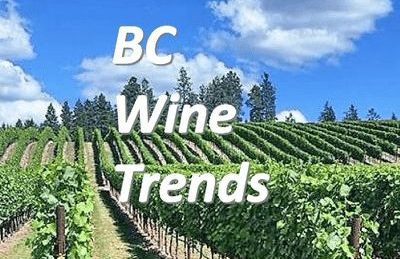Introduction
Precision viticulture is becoming an essential element in managing a vineyard through Climate Change. As one of the emerging leaders, Terraview focuses on blending proven traditional vineyard practices with its leading-edge machine learning and AI to help winemakers effectively transition towards sustainability. They are now extending their platform into British Columbia.

Simon Cairns, Chief Revenue Officer at Terraview, believes that a critical ingredient in the art of winemaking now includes data. At a time when wineries are strategizing how to stabilize, surprise, and then thrive through climate change, a global pandemic, and large-scale wildfires, he brings a refreshingly optimistic outlook to the conversation.
Cairns is a staunch advocate for sustainability as an integral part of the day-to-day vineyard operations. In this interview, we get to know what makes him tick and hear his take on some of the most pressing issues for winemakers.
The Interview
Can you tell us something about your own background and how you got involved in Terraview?
I have a keen interest in innovation, wine, and sustainability. I know we like to romanticize about the tradition and terroir in winemaking, but truthfully the craft is always innovating and evolving. The difference now is the pace of change, and the ability to unlock new opportunities have never been greater. Terraview offered me the chance to explore these subjects.
Can you tell us about the background of Terraview and its main areas of expertise? How would you describe the platform?
We leverage data and machine learning to help vineyards on their transition to sustainability. Vineyards the world over have lots of data – harvest data, weather data, sensor data, satellite imagery, nutrient analysis. But what matters most is enabling vineyards to use that data effectively in their day to day operations. We want to bring all those points together, create an operating system for your vineyard, and provide you with science-driven insights into the likelihood of future challenges such as unexpected temperature shifts that can harm your fruit and predict future diseases that may impact your vines.
What problems are you solving with your technology?
One key area of focus is enabling smart irrigation. As vineyard operators know, not all rows, varietals, or plots are the same. So, as an industry, why do we always hit those with the same amount of water pressure? Here, business optimization and sustainability are directly aligned. If we can throttle the pressure per row, per block, per varietal type, or make adjustments due to sudden spikes in weather or fall-outs in water quality, we can optimize water usage by as much as 60% while also respecting the needs of the vines.
Another area of focus is pre-symptomatic detection of disease and infestations. Using both rich imagery and data patterns, we now can apply probability towards the timing, scope, and rate of spread for common vineyard health risks.
Lastly, we take all the elements of your historical, current, and future-state vineyard that data unlocks for us to enable new capabilities in harvest yield predictions. If everything in your vineyard, from acidity to weather, impacts your harvest, we should be looking at all those historical and current factors to provide visibility into this years’ crop.
What Terraview technologies are you currently using to provide insights for winemakers?
We provide a cloud-based platform that leverages both machine learning, data science, local apps, and high-resolution imagery to create a detailed view of all aspects of your vineyards in both current and future states.
You seem to be firmly focused on sustainability. In what ways can AI help to improve the sustainability of vineyards?
Let’s start with vineyard operations. Data often contains obscure but repeated patterns that can reveal opportunities for optimization when re-arranged and then studied. Data can also show opportunities that represent a wholesale rethinking of how to operate. Machine learning and AI enable us to do these analyses quickly and at scale so that vineyards can not only respond in real-time but take steps in advance to mitigate an impact before it reaches full effect. Instead of waiting days or weeks for lab results to see if a vine may become sick, we can use data to determine this in seconds, often before it’s visible, saving the vine’s life.
But the dialog should not end there. When you look at how data reveals new patterns in wine consumption by consumers, sustainability is rapidly becoming a key ingredient in unlocking both new retailers and direct sales. In other words, sustainability is not just how you survive but how you can thrive.
What are the current challenges you see in wineries? In your experience, what tops their agenda?
Wineries do want to remain focused on the craft and artistry of both viticulture and viniculture. Still, often within the same breath, they note challenges around irrigating effectively or how temperatures are getting less and less predictable. These create challenges not just on fruit quality, yield, or harvest dates. As it takes more effort and tooling to respond, they’re directly impacting their margin on every bottle.
And more specifically, what are the main challenges faced by wineries in Canada?
Here in British Columbia specifically, we see similar trends to elsewhere in the world. Summers are warmer and now longer, which on the first impression creates opportunities for more varietals like cabernet sauvignon. But the transition from winter to spring is more abrupt, no longer a graceful ascendence to warmer climes.
We’re also planting more northward than ever before, the latest wine regions like Lillooet being inconceivable just twenty years ago.
In an industry whose very soul is based on centuries of tradition, the depth and degree of change now mandate we respond with resolve just as we did in those very first plantings.
Are you working with any wineries in British Columbia? If so, what type of collaboration are you carrying out?
We will be announcing our first partnerships shortly.
Can you tell us something about your current projects in other markets?
Our four key launch territories are Spain, France, Australia, and North America. In the US and Canada, we’re working closely with vineyards, helping them leverage the Terraview platform to optimize their day-to-day operations. For Australia, irrigation is front and center as both costs and the increasing need for varying water pressure become the largest concerns for vineyards. European vineyards are impacted by changing temperatures due to climate change, so optimizing canopy cover day to day and providing insights towards their harvest trajectory are critical.

Old world vineyards are usually much more atomized. For example, we are working with Vallformosa, a winery in the Spanish region of Penedés, where they produce fantastic sparkling wines. I hear that you visited the area some time ago, so you will probably know them. The main issue that they face is the management of around 6000 hectares distributed across thousands of plots. Thus, a system to monitor them is vital to maintain and improve quality. Last year they lost a third of their harvest because of an aggressive downy mildew outbreak.
How would you compare the reality of winemaking in Canada to other countries? What differences and similarities do you find?
Canada is a vast territory rich in agricultural bounty. But due to big swings in seasonal temperatures, wide-open spaces, and a lack of people, we’ve always had to be leaders in innovation as we endured hardships on our unique journey. As a result, we’re open to new ideas, testing new technologies, and experimenting with new ideas.
All that being said, I don’t know many winemakers who don’t walk and talk with the vines every day.
What do you think about Canadian wines? Any favourite labels?
BC is producing world-class wines that are becoming true collector vintages. The continued investment and growth of the industry produces an even better product each passing year. I find several to be incredibly impressive and encourage enthusiasts the world over to come and visit beautiful BC and give them a try.
Conclusion
For more information visit the Terraview website.
